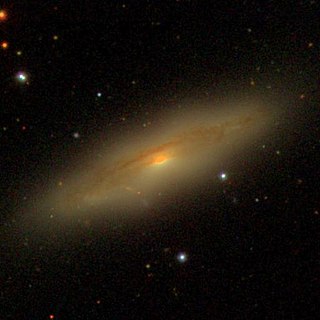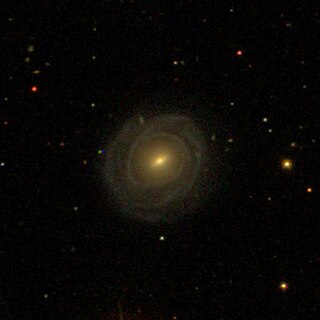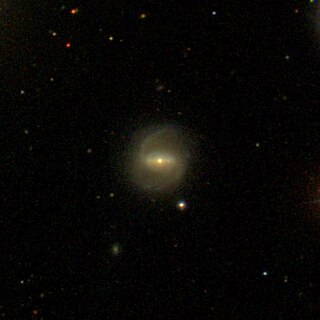
Messier 90 is an intermediate spiral galaxy exhibiting a weak inner ring structure about 60 million light-years away in the constellation Virgo. It was discovered by Charles Messier in 1781.

NGC 1232 is an intermediate spiral galaxy about 60 million light-years away in the constellation Eridanus. It was discovered by German-British astronomer William Herschel on 20 October 1784.

NGC 4309 is a lenticular galaxy located about 55 million light-years away in the constellation Virgo. The galaxy was discovered by astronomer Christian Peters in 1881 and is a member of the Virgo Cluster.

NGC 4536 is an intermediate spiral galaxy in the constellation Virgo located about 10° south of the midpoint of the Virgo cluster. However, it is not considered a member of the cluster. Rather, it is a member of the M61 Group of galaxies, which is a member of the Virgo II Groups, a series of galaxies and galaxy clusters strung out from the southern edge of the Virgo Supercluster. The morphological classification in the De Vaucouleurs system is SAB(rs)bc, which indicates it is a weakly barred spiral galaxy with a hint of an inner ring structure plus moderate to loosely wound arms. It does not have a classical bulge around the nucleus.

NGC 321 is an elliptical galaxy located in the constellation Cetus. It was discovered on September 27, 1864, by the astronomer Albert Marth. Measurements of its redshift put it at a distance of about 217.4 ± 15.4 megalight-years (66.67 ± 4.73 Mpc), assuming a Hubble constant of H0 = 67.8 km/sec/Mpc.

NGC 4262 is a lenticular galaxy located in the constellation of Coma Berenices.

NGC 4492 is a spiral galaxy located about 90 million light-years away in the constellation Virgo. NGC 4492 was discovered by astronomer William Herschel on December 28, 1785. It was rediscovered by astronomer Arnold Schwassmann on January 23, 1900 and was listed as IC 3438. NGC 4492 lies in the direction of the Virgo Cluster. However, it is not considered to be a member of that cluster.

NGC 4586 is a spiral galaxy located about 50 million light-years away in the constellation Virgo. The galaxy was discovered by astronomer William Herschel on February 2, 1786. Although listed in the Virgo Cluster Catalog, NGC 4586 is considered to be a member of the Virgo II Groups which form a southern extension of the Virgo cluster. NGC 4586 is currently in the process of infalling into the Virgo Cluster and is predicted to enter the cluster in about 500 million years.

NGC 4607 is an edge-on spiral galaxy located about 56 million light-years away in the constellation Virgo. NGC 4607 was discovered by astronomer R. J. Mitchell on April 24, 1854. The galaxy is a member of the Virgo Cluster.

NGC 4659 is a lenticular galaxy located about 54 million light-years away in the constellation Coma Berenices. NGC 4659 was discovered by astronomer William Herschel on April 12, 1784 and is a member of the Virgo Cluster.

NGC 4660 is an elliptical galaxy located about 63 million light-years away in the constellation Virgo. The galaxy was discovered by astronomer William Herschel on March 15, 1784 and is a member of the Virgo Cluster.

NGC 4237 is a flocculent spiral galaxy located about 60 million light-years away in the constellation Coma Berenices. The galaxy was discovered by astronomer William Herschel on December 30, 1783 and is a member of the Virgo Cluster. It is also classified as a LINER galaxy and as a Seyfert galaxy.

NGC 4298 is a flocculent spiral galaxy located about 53 million light-years away in the constellation Coma Berenices. The galaxy was discovered by astronomer William Herschel on April 8, 1784 and is a member of the Virgo Cluster.

NGC 4305 is a dwarf spiral galaxy located about 100 million light-years away in the constellation Virgo. The galaxy was discovered by astronomer John Herschel on May 2, 1829. Although considered to be a member of the Virgo Cluster, its high radial velocity and blue luminosity suggest it is in fact a background galaxy. The galaxy has a nearby major companion; NGC 4306.

NGC 4306 is a dwarf barred lenticular galaxy located about 100 million light-years away in the constellation Virgo. The galaxy was discovered by astronomer Heinrich d'Arrest on April 16, 1865. Although considered to be a member of the Virgo Cluster, its high radial velocity and similar distance as NGC 4305 suggest that NGC 4306 is a background galaxy. NGC 4306 is a companion of NGC 4305 and appears to be interacting with it.

NGC 4307 is an edge-on spiral galaxy located about 65 million light-years away in the constellation Virgo. It was discovered by astronomer Christian Peters in 1881 and is a member of the Virgo Cluster. It is also a LINER galaxy.

NGC 4312 is an edge-on unbarred spiral galaxy located about 55 million light-years away in the constellation Coma Berenices. It was discovered by astronomer William Herschel on January 14, 1787. NGC 4312 is a member of the Virgo Cluster and is a LINER galaxy.
The Telescopium−Grus Cloud is a galaxy filament in the constellations of Pavo, Indus, and Telescopium. It was first defined by astronomer Brent Tully in his book The Nearby Galaxies Atlas and its companion book The Nearby Galaxies Catalog.

NGC 4326 is a barred spiral galaxy with a ring located about 330 million light-years away in the constellation Virgo. It was discovered by astronomer William Herschel on April 13, 1784, who described it as "vF, S, R, bM, 1st of 3". It is a large galaxy, with a diameter of around 200,000 ly (61 kpc) making it nearly twice the size of the Milky Way. NGC 4326 is also classified as a LINER galaxy. Despite being listed in the Virgo Cluster catalog as VCC 623, it is not a member of the Virgo Cluster but instead a background galaxy.

NGC 4333 is a barred spiral galaxy with a ring structure located about 330 million light-years away in the constellation Virgo. It was discovered by astronomer William Herschel on April 13, 1784, who described it as "F, pS, R, bM, 2nd of 3". NGC 4333 is also classified as a LINER galaxy. Despite being listed in the Virgo Cluster catalog as VCC 637, it is not a member of the Virgo Cluster but instead a background galaxy.



















